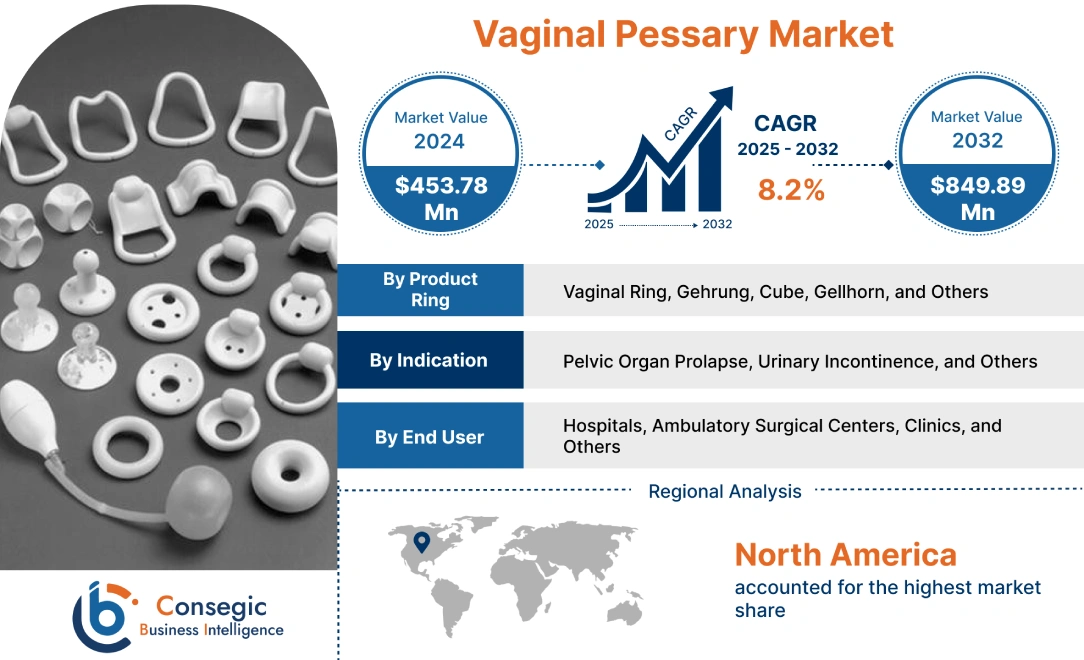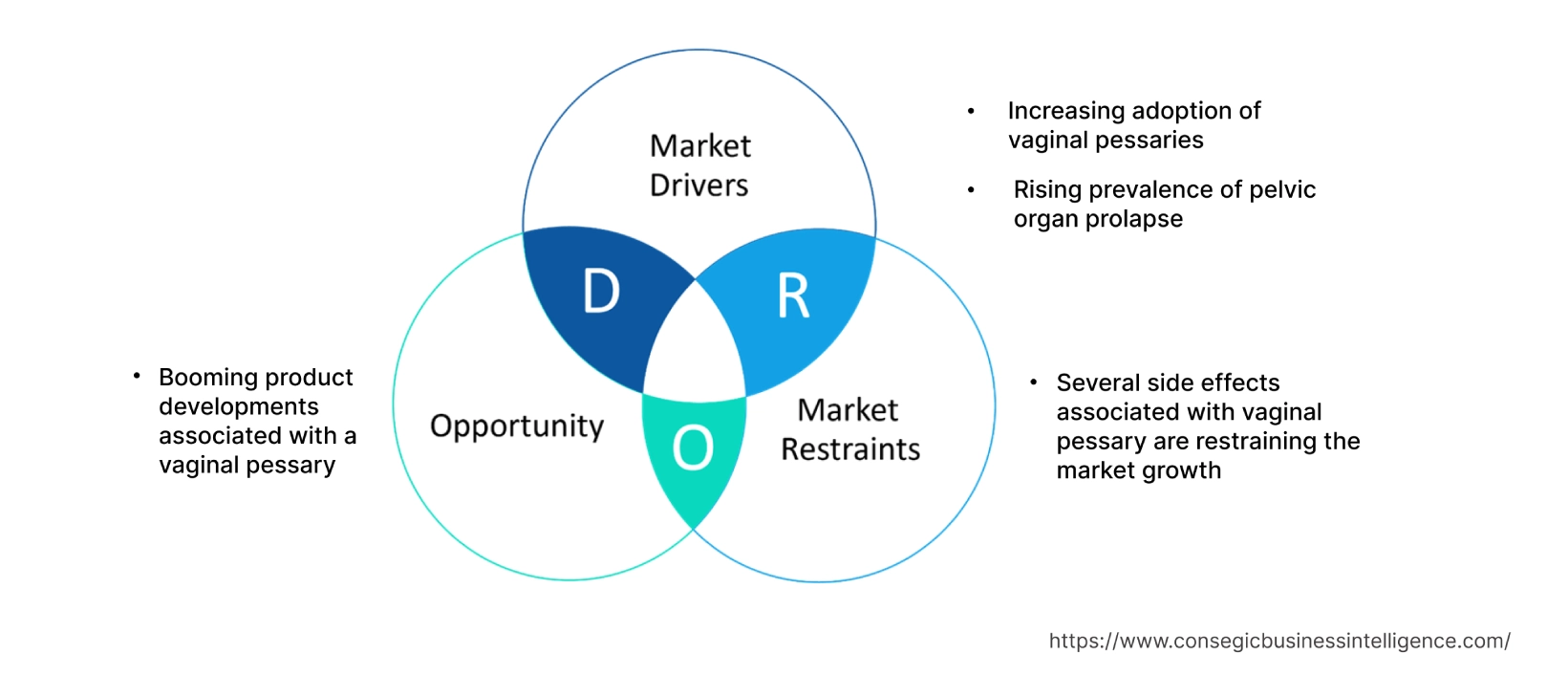- Summary
- Table Of Content
- Methodology
Vaginal Pessary Market Size :
Vaginal Pessary Market size is estimated to reach over USD 849.89 Million by 2032 from a value of USD 453.78 Million in 2024 and is projected to grow by USD 482.72 Million in 2025, growing at a CAGR of 8.2 % from 2025 to 2032.
Vaginal Pessary Industry Scope & Overview:
The vaginal pessary is a small, medical device that is inserted into the vagina to support the pelvic organs. The vaginal pessary is primarily utilized in the treatment of stress urinary incontinence to prevent urinary leakage and to treat pelvic organ prolapse. This maintains the location of organs in the pelvic region. The major types of vaginal pessary include vaginal ring, gehrung, cube, gellhorn, and others. The prominent benefits associated with vaginal pessary include a reduction in the symptoms of vaginal prolapse, less invasive, supports pelvic structures, and others. Furthermore, the vaginal pessary prevents pelvic organ prolapse (POP) from bulging beyond the opening of the vagina. This minimizes the symptoms related to pelvic organ prolapse. As a result, due to the above-mentioned benefits, the vaginal pessary is frequently utilized for various treatments such as pelvic organ prolapse, urinary incontinence, and others.
Vaginal Pessary Market Insights :
Key Drivers :
Increasing adoption of vaginal pessaries drive the market
Vaginal pessaries come in various sizes and shapes to efficiently fit in a woman's anatomy. The vaginal pessary products are composed of medical-grade silicone. This makes vaginal pessary highly durable and resistant to absorption. Thus, due to the above benefits vaginal pessary is frequently deployed in hospitals. For instance, in the United States, the use of pessaries increased from 3.4% in 2010 to 5.3% in 2020. This represents a significant increase, and it suggests that more women are becoming aware of the benefits of pessaries as a treatment option for pelvic organ prolapse. Various hospitals in Germany, including Ludwig Maximilian University Hospital in Munich, University Hospital in Dusseldorf, Vivantes Hospital Group in Berlin, St. Hedwig Hospital in Berlin, and others provide treatment for pelvic organ prolapse & urinary incontinence. These hospitals utilize vaginal pessary products to ensure efficient treatment of patients. Hence, the increasing adoption of vaginal pessary products to support the vaginal tissues displaced by pelvic organ prolapse. This prominent factor is boosting the market growth of the market.
Rising prevalence of pelvic organ prolapse drive the market
The vaginal pessary is utilized for the treatment of pelvic organ prolapse to prevent cystocele. Key trends such as chronic constipation, serious coughing, and others are boosting the cases of pelvic organ prolapse at the global level. For instance, according to recent data published by the National Center for Biotechnology Information, approximately 9.7% of women aged between 20-39 years and 49.7% of women aged above 80 years are suffering from pelvic organ prolapse in 2021. Furthermore, the number of people with pelvic organ prolapse will increase by 59% in 2050. Therefore, the rising prevalence of pelvic organ prolapse at the global level is fuelling the demand for vaginal pessary to relieve the symptoms. This, in turn, is fostering market growth.
Key Restraints :
Several side effects associated with vaginal pessary are restraining the market growth
The frequent use of vaginal pessary can cause several side effects for the patients. For instance, according to the National Health Service (NHS), several side effects associated with vaginal pessary include bleeding from the vagina, lower stomach pain, discomfort around the vagina, burning sensation after putting the pessary in the vagina, and others. As a result, the above side effects associated with vaginal pessary are posing a major bottleneck for the market size growth of the industry during the projected forecast period.
Future Opportunities :
Booming product developments associated with a vaginal pessary spur market opportunities
The key players dealing in the vaginal pessary product range are substantially investing in the product innovations of vaginal pessary, which are utilized for the treatment of pelvic organ prolapse, urinary incontinence, and others. As a result of this, vaginal pessary manufacturers are continuously leveraging their technological potential to develop new products with updated product innovations. For illustration, in June 2021, Femtherapeutics Inc., a Canada-based manufacturer that deals in personalized therapeutics for women announced the development of a custom-made pessary. The device will combine 3D design and artificial intelligence-driven machine learning to relieve discomfort and urine incontinence in women suffering from pelvic organ prolapse. Henceforth, the launch of new products with innovative technology will create a potential opportunity for the expansion of the vaginal pessary market at the global level.
Vaginal Pessary Market Report Insights :
| Report Attributes | Report Details |
| Study Timeline | 2019-2032 |
| Market Size in 2032 | USD 849.89 Million |
| CAGR (2025-2032) | 8.2% |
| By Product Type | Vaginal Ring, Gehrung, Cube, Gellhorn, and Others |
| By Indication | Pelvic Organ Prolapse, Urinary Incontinence, and Others |
| By End User | Hospitals, Ambulatory Surgical Centers, Clinics, and Others |
| By Region | North America, Europe, Asia-Pacific, Latin America, and Middle East & Africa |
| Key Players | CooperSurgical Inc., Panpac Medical Corporation, Integra Lifesciences, MedGyn Products, Inc., Dr. Arabin GmbH & Co. KG, Bray Group Limited, Personal Medical Corporation, Bliss GVS Pharma, Wallach Surgical Devices, and Wellona Pharma |
Vaginal Pessary Market Segmental Analysis :
By Product Type :
The product type segment is categorized into vaginal ring, gehrung, cube, gellhorn, and others. In 2024, the vaginal ring segment accounted for the highest market share in the vaginal pessary market. Vaginal rings are a circle-shaped device and are widely recommended as the first choice by pessary doctors. The primary benefit associated with vaginal rings includes easy insertion and removal. In addition, the patients have intercourse with a ring pessary in place. Thus, due to the above benefits, vaginal rings are utilized for the treatment of urinary incontinence. For instance, according to the recent statistics published by the National Library of Medicine, in October 2020, approximately 43–349 million women in China experienced urinary incontinence (UI). Hence, the increasing prevalence of urinary incontinence is boosting the demand for vaginal rings to minimize irritation, which, in turn, is favoring segment growth.
However, the gehrung segment is projected to be the fastest-growing segment during the forecast period. This is due to the increasing new developments associated with gehrung at the global level, which is spurring segmental growth.
By Indication :
The indication segment is categorized into pelvic organ prolapse, urinary incontinence, and others. In 2024, the urinary incontinence segment accounted for the highest market share in the vaginal pessary market and is projected to be the fastest-growing segment during the forecast period. The urinary pessary is ideal for the treatment of urinary incontinence to minimize or eradicate stress incontinence to support the urethra. Additionally, the utilization of urinary pessary is an economical treatment for urinary incontinence as compared with surgeries. The increasing prevalence of urinary tract infections, constipation, and vaginal infection or irritation is accelerating the prevalence of urinary incontinence. For instance, according to the recent data published by the National Center for Biotechnology Information, in 2021, the prevalence of urinary incontinence in women was highest in Egypt was 80%, followed by America at 59%, the Middle East at 52%, Africa at 45.3%, Australia at 38%, and Europe at 37%. Thus, the rising cases of urinary incontinence are favoring the demand for urinary pessary to reduce stress incontinence. This, in turn, is driving the market growth.
By End-User :
The end user segment is categorized into hospitals, ambulatory surgical centers, clinics, and others. In 2024, the hospitals segment accounted for the highest market share of 35.87% in the overall vaginal pessary market. The vaginal pessary is efficient to help a woman avoid pelvic surgery. Additionally, the vaginal pessary is used as a vessel for slower administration of medication. The patients find they can consistently use a pessary for two years or more without requiring surgery for their condition. Thus, the vaginal pessary is frequently deployed in hospitals. For instance, in India hospitals such as Medanta, Fortis Escorts Heart Institute, Nanavati Super Speciality Hospital., Kokilaben Dhirubhai Ambani Hospital, Sir HN Reliance Foundation Hospital & Research Centre, and others are some of the leading hospitals providing treatment of urinary incontinence and pelvic organ prolapse. These hospitals have formed strategic collaborations with vaginal pessary product manufacturers to ensure a seamless supply of products. Therefore, the rising utilization of vaginal pessary in hospitals to ensure reduction in symptoms is proliferating the market growth.
However, the clinics segment is expected to be the fastest-growing segment during the forecast period. This growth is attributed to factors such as increasing investment in new clinics, increasing government initiatives, and others.
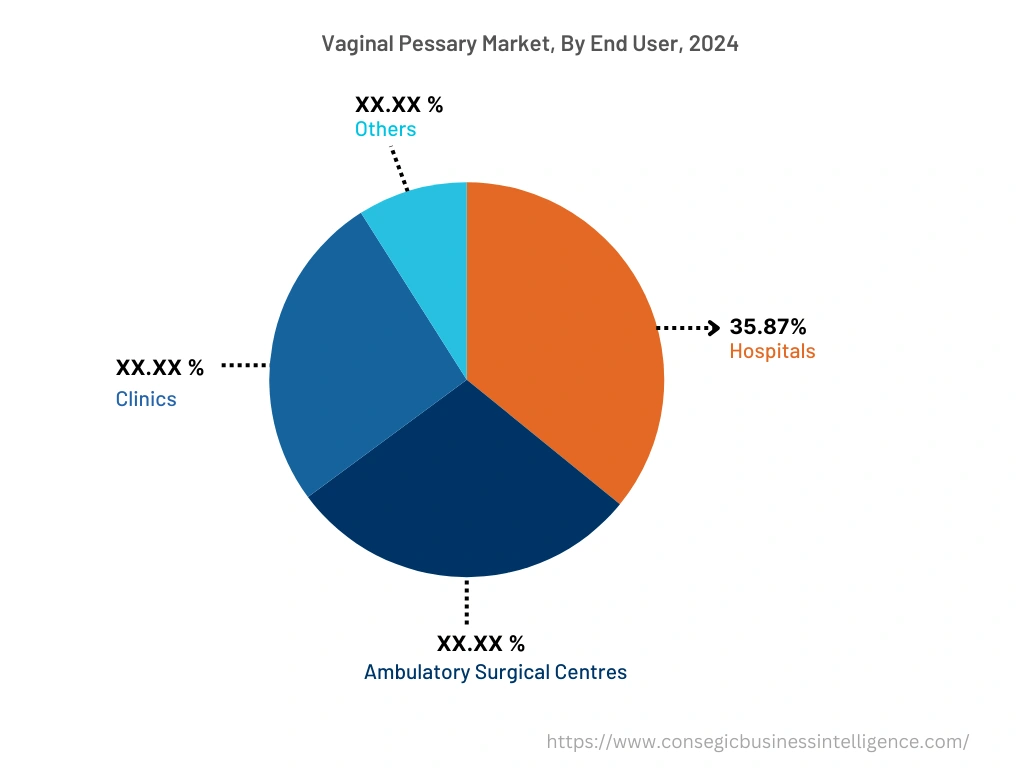
By Region :
The regional segment includes North America, Europe, Asia Pacific, Middle East and Africa, and Latin America.
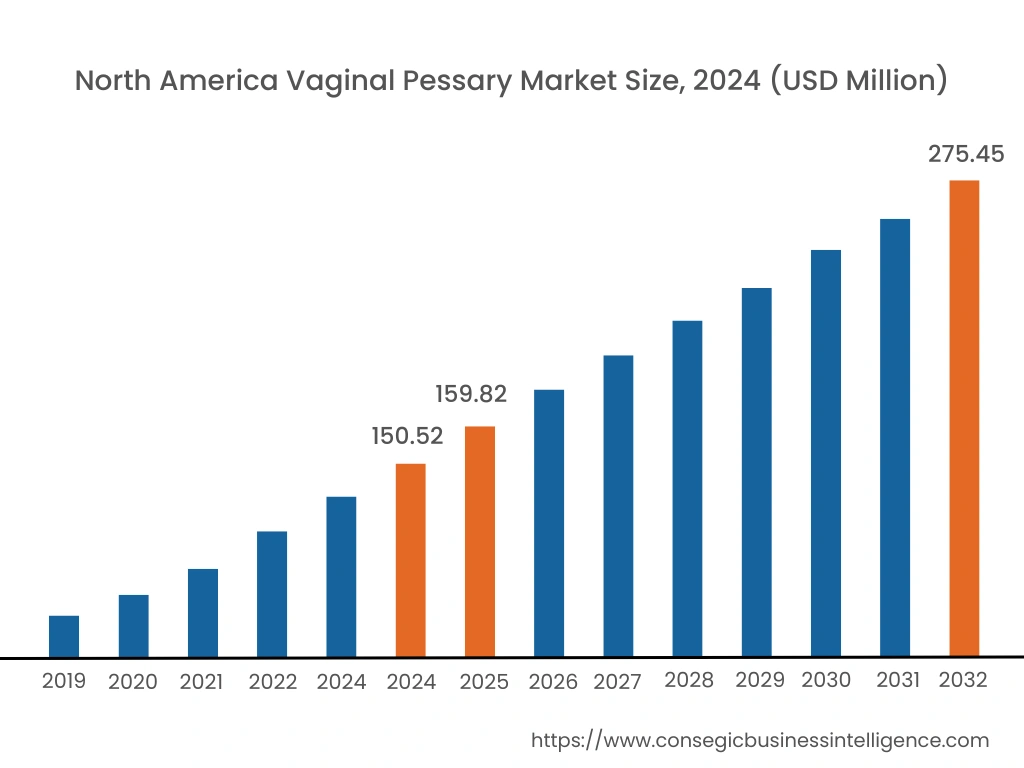
North America is estimated to reach over USD 275.45 Million by 2032 from a value of USD 150.52 Million in 2024 and is projected to grow by USD 159.82 Million in 2025. In North America, the U.S. accounted for the highest market share of 65.75% during the base year of 2024. This is due to the increasing deployment of vaginal pessary products in hospitals, clinics, and others in the North American region. For instance, hospitals in the North American regions such as Hartford Hospital in the United States, Brigham and Women's Hospital in the United States, Mount Sinai Hospital in Canada, and others are providing services for the treatment of urinary incontinence and pelvic organ prolapse. These hospitals employ vaginal pessary products. Thus, the increasing adoption of vaginal pessary products in hospitals across the North American region is favoring market growth.
Furthermore, Asia Pacific is expected to witness significant growth over the forecast period, growing at a CAGR of 8.9% during 2025-2032. Key trends such as the presence of key players in the Asia Pacific region, the development of new hospitals, and others are boosting market growth in the European region.
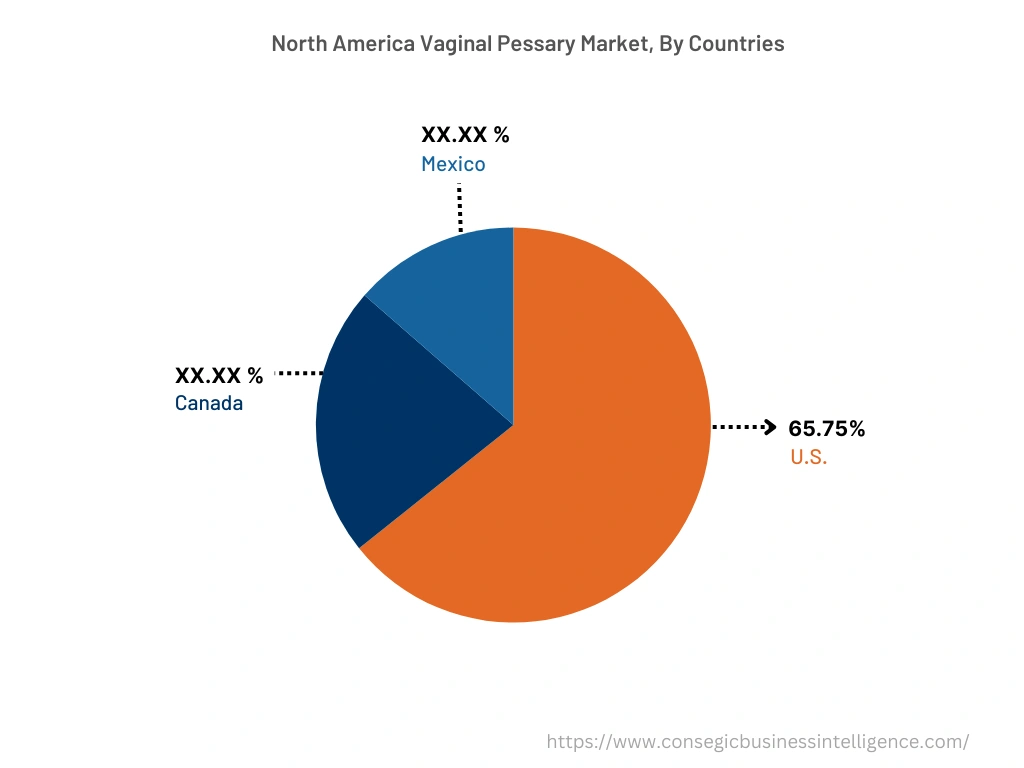
Top Key Players & Market Share Insights:
The vaginal pessary market is highly competitive, with several large players and numerous small and medium-sized enterprises. These companies have strong research and development capabilities and a strong presence in the market through their extensive product portfolios and distribution networks. The market is characterized by intense competition, with companies focusing on expanding their product offerings and increasing their market share through mergers, acquisitions, and partnerships. The key players in the market include-
- CooperSurgical Inc.
- Panpac Medical Corporation
- Bliss GVS Pharma
- Wallach Surgical Devices
- Wellona Pharma
- Integra Lifesciences
- MedGyn Products, Inc.
- Dr. Arabin GmbH & Co. KG
- Bray Group Limited
- Personal Medical Corporation
Recent Industry Developments :
- In May 2023, Indegene Limited, an India-based developer of life sciences commercialization extended the collaboration with ConTIPI Medical Ltd, vaginal solutions for women in Israel. The partnership is focused on the development of a new range of pessary products for the treatment of pelvic floor dysfunction. Thus, partnerships will foster innovations in the markets, thereby favoring industry growth.
Key Questions Answered in the Report
What was the market size of the vaginal pessary industry in 2024? +
In 2024, the market size of vaginal pessary was USD 453.78 million.
What will be the potential market valuation for the vaginal pessary industry by 2032? +
In 2032, the market size of vaginal pessary will be expected to reach USD 849.89 million.
What are the key factors driving the growth of the vaginal pessary market? +
Increasing adoption of vaginal pessaries in hospitals is favoring the market growth at the global level.
What is the dominating segment in the vaginal pessary market by end user? +
In 2024, the hospitals segment accounted for the highest market share of 35.87% in the overall vaginal pessary market.
Based on current market trends and future predictions, which geographical region is the dominating region in the vaginal pessary market? +
North America accounted for the highest market share in the overall vaginal pessary market.
